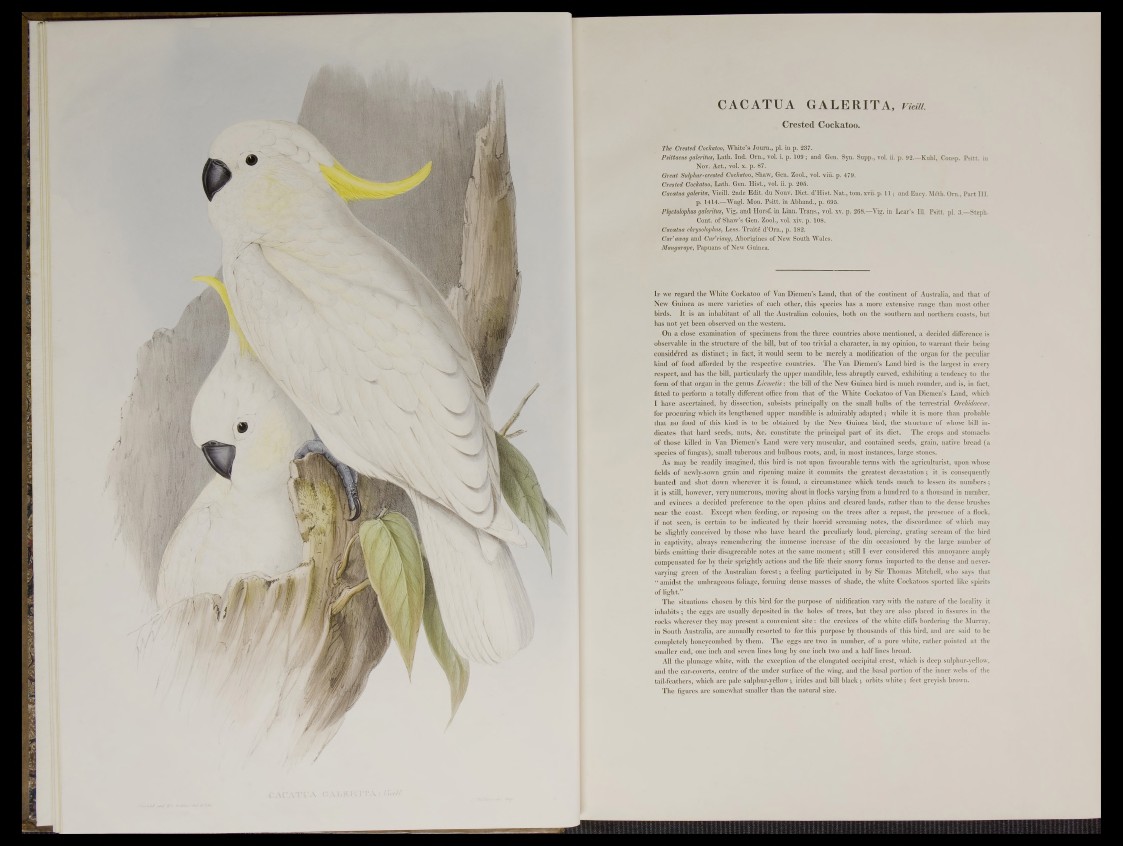
CAGATUA GALERITA, Vida.
„ Crested Cockatoo.
W Ê e k G r e s t e d l . pl. in p. 237.
Psittacus galeritus, W ; and Gen. Syn. Supp., vol. ii.p. 92.—Kuhl, Consp. Psitt in
Great Sulphur-çrpstedi0pch0oo, Shaw, Gen. ZooL. y^.!'yiiivp. 479.
Crested CopkatcojfhÂtWiGep, Hist., T(^fim?p!r205.
Cacatua galerita, Vieilj|^2n4e Edit, du Honv-iMict^ I E ^ MatMom. xvii. p. 1 1 ; and Ency. Méth. Om., Part IIL
Mon. Psitt. m Abhand.,
Plyctolopkus gàleritusjïg£aad Hprsf. in Linn. Trans., in Lear's HI. Psitt. pL 3.—Steph-
Cacatua chrysolophus, Less. Traitefd^Q^^b^ligal^BB
•Car’away'and Cur’riang, Algolagnies
Mangarape, Papuans of New .Gùw.eâ^-;7-
If we'regard t h e A V p f e i . ' - Diemen’s Land, that of the continent .ofë^u^^i'aX and that of
New^ginca: as - mere varie jie s^ ^ ^specie^ h a^ '^ .^ore extensive range than most other
birds. It is an inhabitant of all the|Apst^ h aw coronies.; bptnlon the southern and northern coasts, but
has not yet been obs^ervcd.op.; the western.
On a close examination of shMimenV from the three countries above mentioned, a decided difference is
observable: in. t ^ ^ truGtWMQa^^^^^^iit chUracter^Lin my opinion, to warrant‘their being
considdred^as'^ ^ ^ ^ ^ ^ ^ m p k ' i f would seem to l^ ^ ^ e rely^ai^oQmmt^kof^the organ for the peculiar
M M b o ^ affbrded by the respective countries. The Van Diemen’s Land bird is the largest in every
r^spMp^nd has the bill, particularly the upper mandible, less abruptly curved, exhibiting^ tendency to the
jfnrm'o f that organ in th ^ ^ ^ tS ;J&ic»?e^: the bill of the New Guinea bird is much rounder, and % in fact,
fitted to perform a that of the WhitefGocM^^ d ^V an Diemen’s Land, which
I have ascertained,,by dissection, Subsists principally jpn|the smml^^nip^p ^ the terrestrial Orchidacea?,
^Qr^procuringt|vhich its lengthened upper mandible is admirably adapted; while it;j is rpore than probable
that no ;food; ;of this kind is Ao/be obtained by the New Guinea bird, the structure of whose bill indicates
that hard seeds, nuts?^ ^ ^ fó h stiw^ gV e principal part of its diet. ' The crops and stomachs
jpf^those killed in Van Diemen^s Land sw c re ^ é% ^ ^ ^ ^ ^® ^ a d dM to ^ ^ è u f^ ^ p ^ ^ a in ^m aw e bread (a
ispbcies of fungus), small|fab e r0 u ^m ^ ^ i^ ^ ^TO ts^h ^ ^ ^ ^mO ^ itfim h cfe^ large,stonra£ vgp
As may be i c ^ ^ ^Miagined. this bird is not upon favourable tgpnis with the M^lcm^mskiunon whose
^fields of hcwlyrsbwn grain and rip e j^ ^ f^ a i|gM | commits the greatest devastation; it (is consequently
hunted andfJshot down whe r£y<^s|l|||lfqjm||^ lessen its numbers;
it is still, however, very nutiner^^,Amoving about in flocks varying from a hundred to a thousand in number,
^and| evinces a decided preference tó^he open plains and cleared lands, rather than to the dense brushes,
pear the eoast.— Except when feeding, or lreposhig on the trees after/a re p ^ t/ thiei presence of a flock,
if not seep,- i§ certain to- hdiindi^^MK^^nm^hormd^^sbre^ming^notes. the discordance o f wSfe|| may
be slightly conceived by those who have heard the' peculiarly loud, piercing, grating scream of the,, bird?
in captmty^ajytays remembering the immense increase of th n ^ ^ ^ g ^ aon ^ ^ hwthe large number of
.birds emitting flne'foS disagreeable notes a t the s am ë -m pm ^m ^ ^ ll ever considered this annoyance amply
compensated for by their sprightly actions and the KJeitheir snowy forms imparted to the dense sudmever-
varying g ié f e o f the Australian ^ forest; a feeling participated in by Sir Thomas Mitchell, who says, that
/^ anaidst the umbrageous foliage, forming dense masses- o f shadedfchfe^ ^ ^ ^ i ^ f a to ds sported like spirits
-pÊlfght*” V
The situations chosen^^®is|oird för the purpose of nidification vary with the nature’ Of'the~locality it{
inhabits ; the eggs are usually deposited in the holes of trees, but they are also placed in fissures in the
rocks wherever they may present the crevices of the white cliffs bordering the Murray,
in South Australia, ^ e l^ ^ n ^ u y jrë s o rté d% ^ ^ fó ft^ é ]^ ^ ^ ^ b y thousands of this bird, and are said to be
completely honeycombed by them. The eggs are two in number, of a pure white, rather pointed at the
smaller end, one inch and seven lines long -
AH the plumage white,' with the exception of the elongated occipital crest, which is deep sulphur-yellow,
and the ear-coverts, centre gf Abe under surface of the wing, and the basal* portion of tjie inner webs of the
tail-feathers, which are pale sulphur-yellowifmelf and ;^o|iits white; feet greyish brown.
Tlie figures are somewhat sm§^ve ^ t ^ b the natural "sizè>. ,y